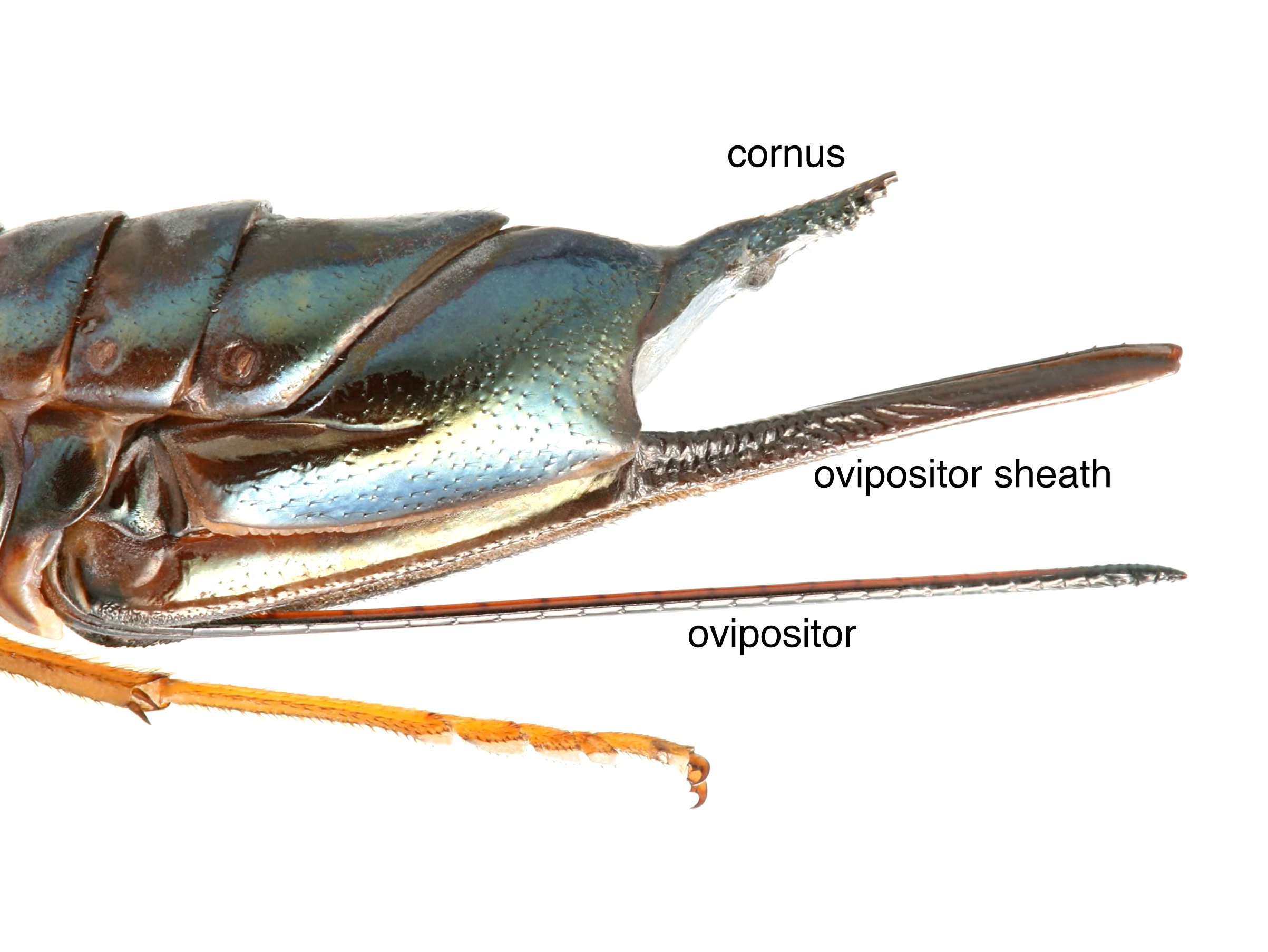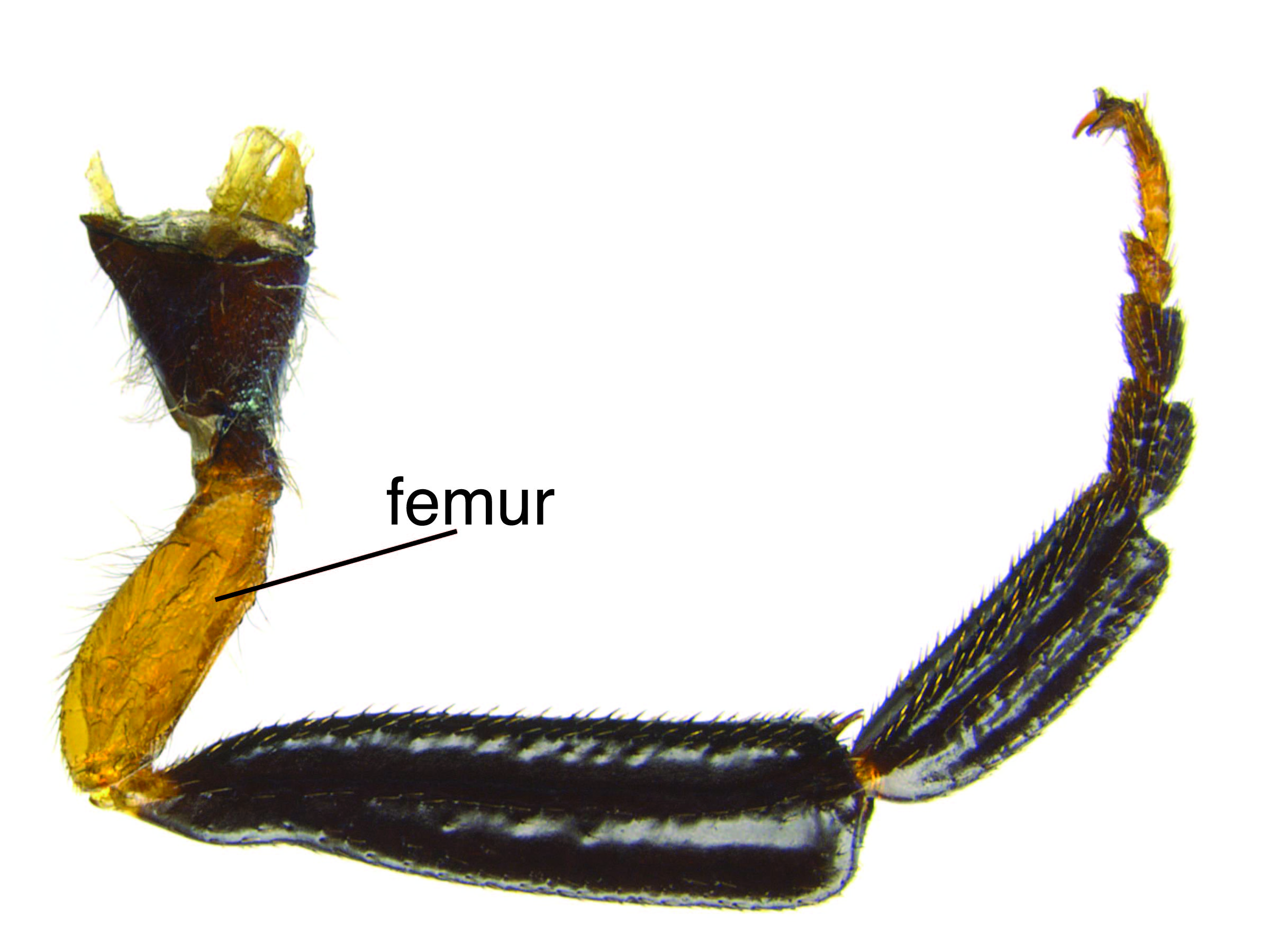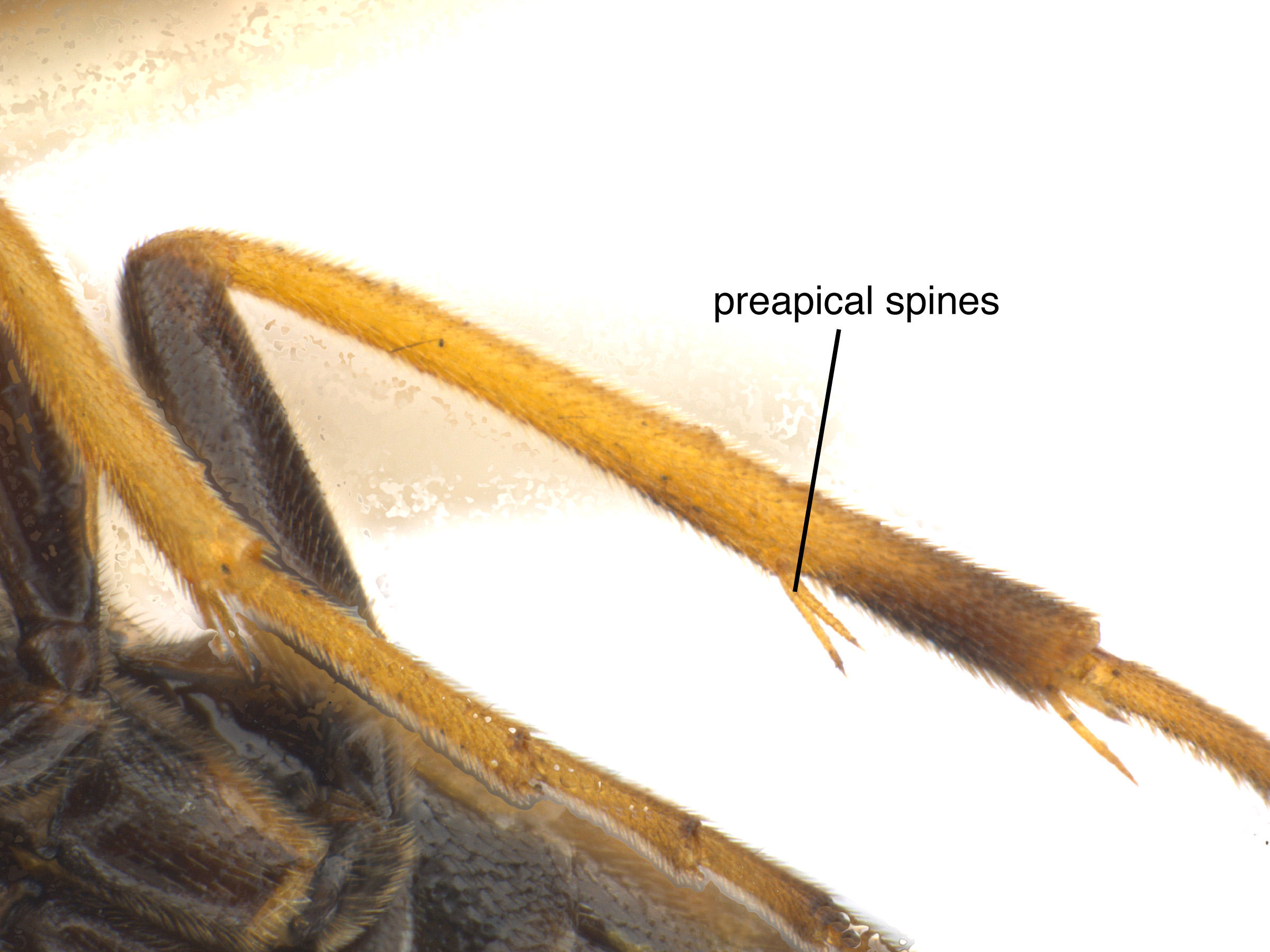Family: Cimbicidae
Family common name: cimbicid sawflies
Subfamily: Cimbicinae
Genus: Trichiosoma Leach, 1817
Subgenera: none
The family Cimbicidae is relatively uncommon and little-studied in North America. However, their large size and metallic reflections make the family somewhat conspicuous (Taeger 1998Taeger 1998:
Taeger A. 1998. Bestimmungsschluuml;ssel der Keulhornblattwespen Deutschlands (Hymenoptera: Cimbicidae). In: Taeger A and Blank SM. 1998. Pflanzenwespen Deutschlands (Hymenoptera, Symphyta). Kommentierte Bestandsaufnahme. Goecke amp; Evers, Keltern: 193-205.). Cimbicidae are robust, with the general shape of a bee, long hairs, and clubbed antennaeantenna:
the sensory organ emerging from the front of the head, usually between the compound eyes and above the clypeus; includes the flagellum, scape and pedicel
 (Smith 1993Smith 1993:
(Smith 1993Smith 1993:
Smith DR. 1993. Systematics, life history, and distribution of sawflies. Pp. 3-32. In: Wagner MR and Raffa KF, eds. Sawfly Life History Adaptations to Woody Plants. University of Minnesota Academic Press. 581 pp.).
Trichiosoma are considered one of the “giant” sawflies because of their large size (~2.5 cm) compared to most other Symphyta. The combination of the large size and yellow- and black-striped coloration results in these sawflies appearing to mimic wasps from the family Vespidae. Males have notably enlarged mandibles, but because size and coloring are variable, sex is best determined by the presence or absence of an ovipositorovipositor:
the female organ that deposits eggs and is used to drill into plant tissue, located at the apex of the abdomen, made up of the lance and lancet
 (Smith 1993Smith 1993:
(Smith 1993Smith 1993:
Smith DR. 1993. Systematics, life history, and distribution of sawflies. Pp. 3-32. In: Wagner MR and Raffa KF, eds. Sawfly Life History Adaptations to Woody Plants. University of Minnesota Academic Press. 581 pp., Vilhelmsen 2019Vilhelmsen 2019:
Vilhelmsen L. 2019. Giant sawflies and their kin: morphological phylogeny of Cimbicidae (Hymenoptera). Systematic Entomology 44: 103-127. https://doi.org/10.1111/syen.12314).
Worldwide, there are 38 extantextant:
in existence; opposite of extinct
described species restricted to the Northern Hemisphere. Four species occur in North America (Taeger et al. 2010Taeger et al. 2010:
Taeger A, Blank SM, and Liston AD. 2010. World Catalog of Symphyta (Hymenoptera). Zootaxa 2580: 1-1064.).
 (Nikolic et al. 2007Nikolic et al. 2007:
(Nikolic et al. 2007Nikolic et al. 2007: (Nikolic et al. 2007Nikolic et al. 2007:
(Nikolic et al. 2007Nikolic et al. 2007: separated from the dorsaldorsal:
separated from the dorsaldorsal: with apicalapical:
with apicalapical: spur present (Goulet 1992Goulet 1992:
spur present (Goulet 1992Goulet 1992:Trichiosoma can be confused with other Cimbicidae. In North America, they can be distinguished from Abia by their larger body size and the parallel inner eye margins, and from Cimbex by the presence of apicalapical:
towards the apex; farthest away from the body
spur on the femorafemur:
the third segment of the leg between the trochanter and the tibia
 (Taeger et al. 1998Taeger et al. 1998:
(Taeger et al. 1998Taeger et al. 1998:
Taeger A, Altenhofer E, Blank SM, Jansen E, Kraus M, Psychorn-Walcher H, and Ritzau C. 1998. Kommentare zur biologie, Verbreitung und Gefahrdung der Pflanzenwespen Deutschlands (Hymenoptera, Symphyta). Kommentierte Bestandsaufnahme 364 (3): 49-135.). Trichiosoma are noticeably hairier than the other Cimbicidae (Goulet 1992Goulet 1992:
Goulet H. 1992. The genera and subgenera of the sawflies of Canada and Alaska: Hymenoptera. Symphyta. The insects and arachnids of Canada. Part 20. Agriculture Canada Publication.).
none
In North America, documented hosts for Trichiosoma include the genera Alnus (alder), Betula (birch), Prunus (cherry), Ulmus (elm), Populus (poplar), Salix (willow), Corylus (hazel), and Fraxinus (ash) (Wong 1954Wong 1954:
Wong HR. 1954. Common sawflies feeding on white birch in the forested areas of Manitoba and Saskatchewan. The Canadian Entomologist 86 (4): 154-158., Smith and Middlekauff 1987Smith and Middlekauff 1987:
Smith DR and Middlekauff WW. 1987. Suborder Symphyta. In: Stehr FW ed. Immature Insects. Kendall/Hunt Publishing Company. Vol. 1: 754 pp.). There is evidence that Salix (willow) is the preferred host of Trichiosoma triangulum (Wong 1954Wong 1954:
Wong HR. 1954. Common sawflies feeding on white birch in the forested areas of Manitoba and Saskatchewan. The Canadian Entomologist 86 (4): 154-158.).
Ovipositing females position themselves by clinging to the margin of a leaf, legs on either side. They steady the leaf margin using their ovipositorovipositor:
the female organ that deposits eggs and is used to drill into plant tissue, located at the apex of the abdomen, made up of the lance and lancet
 sheath, then insert the ovipositorovipositor:
sheath, then insert the ovipositorovipositor:
the female organ that deposits eggs and is used to drill into plant tissue, located at the apex of the abdomen, made up of the lance and lancet
 saw between the cuticle and parenchymaparenchyma:
saw between the cuticle and parenchymaparenchyma:
in plants, the soft, thin-walled, inner tissue that performs functions such as photosynthesis, storage, and secretion; as opposed to dermal and vascular tissues
along the upper surface. The sawsaw:
ovipositor
moves back-and-forth to create a horizontal cavity. The egg is then deposited into this cavity (Chapman 1914Chapman 1914:
Chapman TA. 1914. The egg-laying of Trichiosoma (Tenthredinidae). Transactions of the Entomological Society of London 62 (1): 173-191. https://doi.org/10.1111/j.1365-2311.1914.tb01394.x).
Larval Trichiosoma are external defoliators. The larvaelarva:
the immature stage of holometabolous insects
 are caterpillar-like, usually green or gray with dark spots, and can be recognized by the one-segmented antennaeantenna:
are caterpillar-like, usually green or gray with dark spots, and can be recognized by the one-segmented antennaeantenna:
the sensory organ emerging from the front of the head, usually between the compound eyes and above the clypeus; includes the flagellum, scape and pedicel
 and tarsal claws on each of the five-segmented thoracicthoracic:
and tarsal claws on each of the five-segmented thoracicthoracic:
of or on the thorax
legs (Smith and Middlekauff 1987Smith and Middlekauff 1987:
Smith DR and Middlekauff WW. 1987. Suborder Symphyta. In: Stehr FW ed. Immature Insects. Kendall/Hunt Publishing Company. Vol. 1: 754 pp.).
Larvae react to potential predators by excreting a clear defensive liquid, a behavior called “reflex bleeding”, then fall to the ground, where they become difficult to see. At maturity, the larvalarva:
the immature stage of holometabolous insects
 will drop to the soil surface and build a cocoon in leaf litter. The prepupae overwinter in these cocoons. After pupation, the adult chews a circular hole in the cocoon and emerges (Harizanova et al. 2012Harizanova et al. 2012:
will drop to the soil surface and build a cocoon in leaf litter. The prepupae overwinter in these cocoons. After pupation, the adult chews a circular hole in the cocoon and emerges (Harizanova et al. 2012Harizanova et al. 2012:
Harizanova V, Stoeva A, and Rector BG. 2012. Host range testing and biology of Abia sercea (Cimbicidae), a candidate for biological control of invasive teasels ( Dipsacus spp.) in North America. Journal of Hymenoptera Research 28: 1-11. https://doi.org/10.3897/JHR.28.3044, Smith and Middlekauff 1987Smith and Middlekauff 1987:
Smith DR and Middlekauff WW. 1987. Suborder Symphyta. In: Stehr FW ed. Immature Insects. Kendall/Hunt Publishing Company. Vol. 1: 754 pp.).
Trichiosoma are univoltineunivoltine:
describing an insect with a life cycle of one generation per year
(Smith and Middlekauff 1987Smith and Middlekauff 1987:
Smith DR and Middlekauff WW. 1987. Suborder Symphyta. In: Stehr FW ed. Immature Insects. Kendall/Hunt Publishing Company. Vol. 1: 754 pp.), and adults fly in the spring (Burch 1973Burch 1973:
Burch BJ. 1973. Notes on the pupation of the sawfly, Trichiosoma triangulum (Hymenoptera). Proceedings of the Iowa Academy of Science 80 (2): 59.). Adults have been observed using their mandibles to girdle small twigs near the oviposition site (Eaton and Kaufman 2007Eaton and Kaufman 2007:
Eaton ER and Kaufman K. 2007. Kaufman Field Guide to Insects of North America (Kaufman Field Guides). Houghton Mifflin Harcourt. 391 pp.).
World: This genus occurs throughout Asia, Europe, and North America (Taeger et al. 2010Taeger et al. 2010:
Taeger A, Blank SM, and Liston AD. 2010. World Catalog of Symphyta (Hymenoptera). Zootaxa 2580: 1-1064.). Most collections have been made in Northern Europe, the Mediterranean region, and east to Siberia, Mongolia, Korea, and Japan (Sundukov and Lelej 2009Sundukov and Lelej 2009:
Sundukov YN and Lelej AS. 2009. Sawflies (Hymenoptera, Symphyta) of the Russian Far East. Additions and corrections. Far Eastern Entomologist 200: 1-12.).
North America: Trichiosoma species range north of Mexico throughout the continental United States and Canada, north to Alaska (Discover Life 2019Discover Life 2019:
Discover Life. Accessed January 2019. https://www.discoverlife.org, Eaton and Kaufman 2007Eaton and Kaufman 2007:
Eaton ER and Kaufman K. 2007. Kaufman Field Guide to Insects of North America (Kaufman Field Guides). Houghton Mifflin Harcourt. 391 pp.).
Map data from: GBIF.org (26 June 2019) GBIF Occurrence Download Trichiosoma
Details about data used for maps can be found here.